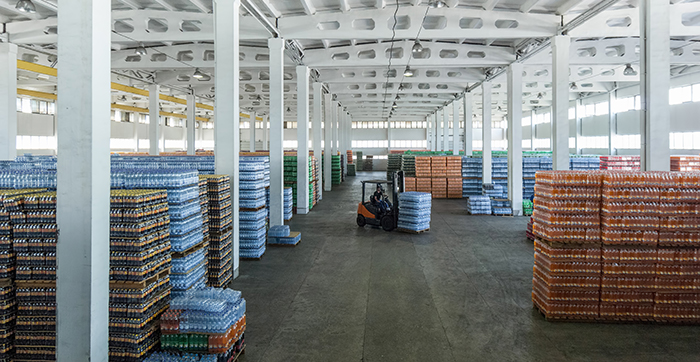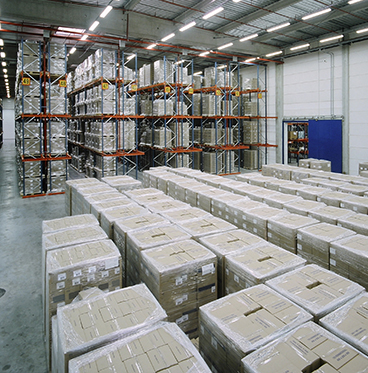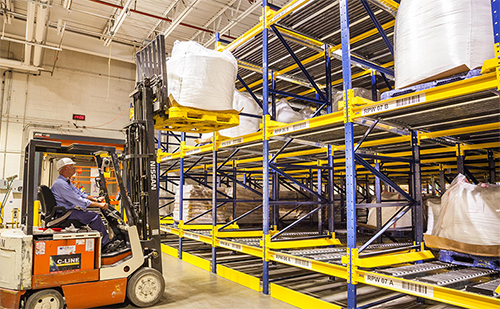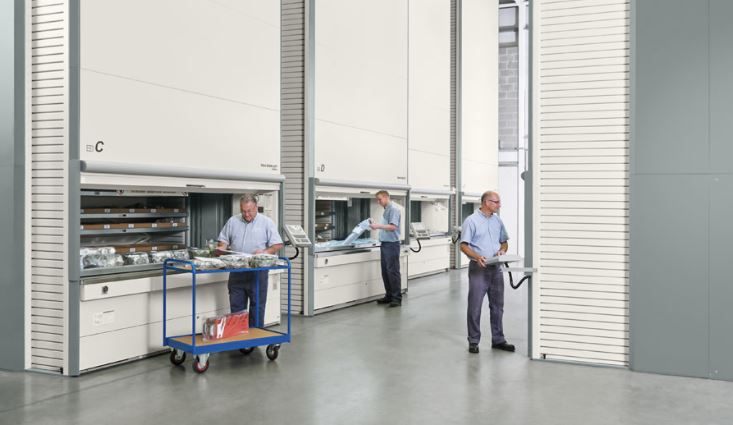How to Design and Utilize Storage Buffers
Buffers let you temporarily store and hold goods until they move to the next process step

Buffers can be found in most warehouses and manufacturing facilities, and they take many forms. You can build buffers into racks, floor space, conveyors or external storage areas like truck trailers. When you need to temporarily store materials before they enter putaway, shipment, kitting, processing, or another production process, what are some of the best design, equipment specification and usage practices?
Processes that involve assembly, order fulfillment and kitting are where you commonly find buffers. They bridge the gap when supply, timing and demand don’t match. Buffers hold goods until they’re needed for a variety of reasons or at a point in manufacturing when partially-finished goods are held until needed.
What makes temporary storage a storage buffer?
Storage buffers and temporary storage are similar, but effective buffers tend to be more defined. In a well-designed buffer, you may block stack items in an open area or slot them into racks or other storage equipment until they’re needed for a particular process; you may hold them in a conveyor system. If something consistently moves from a buffer and into production, you may need a permanent solution for that item.
- Buffers are defined by size, scope and area. They’re often separated from the rest of the warehouse. Buffers accommodate materials until you need that material. In manufacturing that may mean raw materials or partially assembled components awaiting assembly or the next step in the process. For distribution operations, that could mean inventory that isn’t quite ready for putaway. Buffers tend to be fluid, without fixed storage slots, but that’s not always the case.
- Temporary storage isn’t as well defined as true storage buffers. It’s perfectly fine to store things temporarily in open space, but that tends to be a reaction to needs. Storage buffers are more strategic. They’re designed with the next step in mind and are part of a good initial warehouse layout.
To be effective, buffer storage should be space-efficient and agile. It should be organized so that inventory is relatively easy to find and pick. Stock should be able to enter and depart the storage buffer at the right time.
Storage buffers are almost always bulk storage of pallets, but in some cases can be totes, small containers or other types of materials.
Block stacking for large numbers of similar or same SKU when space is not an issue

Block stacking tends to be used for large quantities of similar or identical, durable items and good pallets that reduce crushing risks. Block stacking requires extensive forethought and detailed planning.
One of the most common storage buffers is to block stack pallets, usually on the floor. If the load profile and space limitations fit for block stacking, it’s an excellent way to execute a storage buffer. Pallets are stacked atop each other to stable heights in a block stacked storage buffer. Factors include:
- Lane design: Forklift operators will require room to operate throughout the area to efficiently locate and remove pallets.
- Load strength: Can you stack your palletized load without damaging the product?
- Load stability: Can the product be stacked? Can it be stacked high enough for the area you have to make it effective?
- Pallet conditions: Your pallets must be undamaged, strong and stable enough for stacking.
- Environment: Be certain temperatures and humidity can’t damage pallets or your load. Whatever you’re storing, it should be in identical or similar conditions to its final storage positions or processing area.
- Space considerations: Block stacking is a space hog, so you’ll need ample square footage for it.
Remember that block stacking is always a last-in, first-out storage method, so it can be used only for items that don’t require rotation or freshness. It’s not a flexible method, since removing pallets creates a void that you can’t easily restock. Also, since you’re stacking, you may want to limit the number of SKUs per area so you don’t “trap” any stock behind other items. Be certain of your safe stacking limits when you undertake a block stacking operation.
Read more: The Case for a “Supersized” Receiving Area in Your Warehouse
Rack storage for storage density, picking agility, organization and safety

While block-stacked buffers are perhaps the most common type of buffer, storage racks are more flexible and space-efficient. For the right inventory count, SKU mix and warehouse flow, racks make more sense. If you need more operating area, one of the first places to look is at bare floors used for temporary storage or buffers. More importantly, storage racks give you flexibility. You aren’t locked into one way to load and a constant dance of pallets moving in and out. Rack storage also works for more types of loads, including fragile and date-sensitive inventory.
You can access the pallet when you need it without reorganization or storage voids with rack systems, which isn’t always true of floor stacks.
- Selective racks: Because it uses the vertical cube, selective rack is higher density than block stacking. It’s more organized than floor pallets and protects inventory from crushing or smashing accidents. It’s the most flexible of all rack types, since you can access every pallet all the time. Use it when your buffer has a broad diversity of products and space is less demanding.
- Pushback racks: Pushback systems aren’t as flexible as selective racks but are much more space-efficient. You can store one SKU per position, up to 8 pallets deep.
- Drive-in racks: These racks are similar to block stacking (one SKU per lane, last-in-first-out) but allow you to more easily access inventory. They’re one of the most space-efficient storage buffer methods.
- Pallet flow racks: For storage buffers, flow racks are the ideal choice when it comes to time-critical items that require inventory rotation. They are highly space efficient, as a single SKU can be stored in long flow lanes for easy access at the pick face.
Rack provides faster entrance and exits than block stacking for storage buffers
Rack storage of any type is more organized than block stacking. When it comes to placing pallets, block stacking is easier when you have naked floor and the ability to move in and out. Once things get crowded, racks are faster to place and are always faster to extract. Most importantly, racks are more stable than high-stacked pallets of goods, making them safer to operate.
Automated systems: AS/RS, pallet shuttles and Carousels for process buffering

A buffer storage using carousels, pallet shuttles or automated storage-retrieval systems typically sits between production lines or process areas rather than in a remote storage area. . In a manufacturing operation, you could have a sub-assembly buffer for finished components awaiting the next step in the task buffered in an automated system. You don’t need those parts right now, but when you do, you’ll have them ready to use without jamming the production zone.
Automated systems have several advantages for the correct application, including:
- Storage density: If you’re pressed for space, a carousel or ASRS can store up to 60% more than storage than comparable static storage. These systems are much more space-efficient than static storage or block stacking.
- Accessibility: Automated systems make it much easier to queue up buffered items when you need them. When paired with your WMS, you will
- Organization: Buffered items will always be in a defined storage slot, typically known by your WMS. When needed, it can automatically deliver it to pickers or assembly employees — no searching or waiting required.
- Ergonomics: Carousels and ASRS can deliver products at exactly the right “golden zone” height and position.
Carousels tend to store mostly smaller items, but ASRS unit load systems can handle full pallets and release them as needed. Pallet shuttles are frequently used for storage buffers in high-density, high-output processes.
Conveyor-based process buffers for hold & release applications

Conveyors are used similarly to automated solutions buffers: as a holding area between process steps. Products buffer before moving on to the next step in the, whether order fulfillment or manufacturing. Many conveyor types function as both transport and buffering methods. They balance operational surges by allowing you to hold products while one operational area catches up with another.
- Overhead conveyors can hold recently painted or washed items until dry. This is a frequent manufacturing application.
- Accumulation conveyor systems frequently buffer cartons before they reach a packing function. It’s common to queue up totes or cartons until they can be weighed, checked, packed, taped or processed to ship.
- Spiral accumulation buffers divert products into high-density vertical spirals that use overhead rather than floor space. This is frequently used for vertical accumulation of items for cooling, drying, or other processes. This allows you to buffer and control the pace for a large number of products in a small footprint. You can set what items, and when they merge to the spiral or continue, giving you the flexibility to move forward when appropriate or buffer when needed.
Most conveyor types can be used in buffering roles, depending on the load, volume and situation involved.
Buffers let you set timing and create straight-line production processes
Any process that can be sequenced and involves pauses, delays, or waiting periods tends to involve buffering. Most warehouses and factories use temporary storage or dedicated buffers. Optimizing these processes can make a big difference in overall productivity. If you need advice or assistance, call us today.
Read more:
- How to Optimize Packing Processes
- How Simulation Adds Value to Material Handling Systems Specification
- Pallet Rack Storage Ideas for Difficult Loads and Situations
Scott Stone is Cisco-Eagle's Vice President of Marketing with 35 years of experience in material handling, warehousing and industrial operations. His work is published in multiple industry journals an websites on a variety of warehousing topics. He writes about automation, warehousing, safety, manufacturing and other areas of concern for industrial operations and those who operate them.



